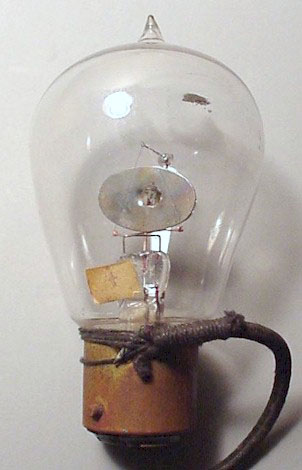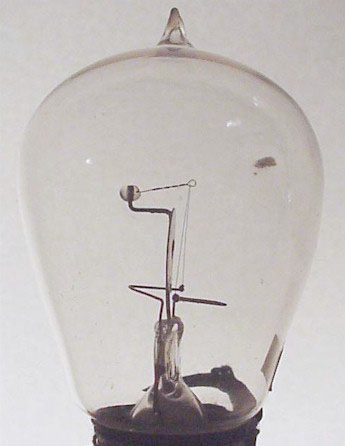|
The Fleming Valve |
 |
| The
Fleming Valve is a diode that was used as a radio signal detector in the
earliest days of radio communication.
In the early 1880's, as part of his efforts to improve his incandescent light bulb, Thomas Edison investigated the darkening that occurred inside the bulb with extended use. He built bulbs containing a metal plate located in close proximity to the filament, and observed a current flow from the filament to the plate during operation. He called this the "Edison Effect", and was issued a patent for this device as part of an electrical indicator in 1884. He did not, however, recognize it for it's potential as a rectifier. In 1899, John Ambrose Fleming, who worked for the British Marconi Company, was seeking a more sensitive detector for wireless reception, and he tried the Edison Effect bulb for this purpose, and found that it worked well. He applied for, and received a US patent (no. 803,684, 11/7/05) for this device, claiming himself as the inventor, which was not the case. The litigation wars that erupted over this device, and DeForest's modification to it (the addition of the grid) lasted for decades, and were not finally settled until 1943. The US Supreme Court finally ended the battle by agreeing with Fleming's opponents, and ruled his patent invalid, though by then it had long since expired. For a time, the battles over the interlocking Fleming and DeForest patents prevented the legal commercial manufacture of vacuum tubes, and eventually led to the formation of the industry giant, RCA. |
 |
|
This example is one of perhaps 700 that were manufactured in the period of 1910-1915, and was used by the American Marconi Company in commercial service. It used a standard British two contact bayonet base (for the filament). A wire lead soldered to the brass shell of the base was used for the plate connection. The dark spot is some impurity in the glass. It measures about 3 inches high, and about 1 1/2 inches in diameter, at its widest point. This tube shown here was found stuffed into a carton that originally held a WD-11 tube. That carton was lying at the bottom of a box of old radio parts and tubes that I purchased at a junk auction in the area. It had good company. With it was a DeForest Spherical Audion, four AudioTrons, several Moorhead tubes, and a number of other choice items, including the WD-11. I would love to know how that assemblage came to be, but that story went to the grave with its owner. |